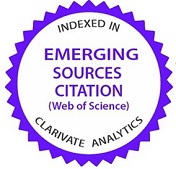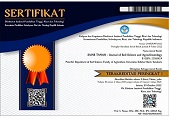Chemical modification of biochar’s functional groups enhances phosphate and arsenite adsorption
Abstract
Keywords
Full Text:
PDFReferences
Abney, R. B., & Berhe, A. A. (2018). Pyrogenic Carbon Erosion: Implications for Stock and Persistence of Pyrogenic Carbon in Soil [Review]. Frontiers in Earth Science, Volume 6 - 2018. https://doi.org/10.3389/feart.2018.00026
Ahangaran, F., Hassanzadeh, A., & Nouri, S. (2013). Surface modification of Fe3O4@SiO2 microsphere by silane coupling agent. International Nano Letters, 3(1), 23. https://doi.org/10.1186/2228-5326-3-23
Akgül, G., Maden, T. B., Diaz, E., & Jiménez, E. M. (2018). Modification of tea biochar with Mg, Fe, Mn and Al salts for efficient sorption of PO43− and Cd2+ from aqueous solutions. Journal of Water Reuse and Desalination, 9(1), 57-66. https://doi.org/10.2166/wrd.2018.018
Alchouron, J., Navarathna, C., Chludil, H. D., Dewage, N. B., Perez, F., Hassan, E. B., . . . Mlsna, T. E. (2020). Assessing South American Guadua chacoensis bamboo biochar and Fe3O4 nanoparticle dispersed analogues for aqueous arsenic(V) remediation. Science of The Total Environment, 706, 135943. https://doi.org/10.1016/j.scitotenv.2019.135943
Aller, D., Bakshi, S., & Laird, D. A. (2017). Modified method for proximate analysis of biochars. Journal of Analytical and Applied Pyrolysis, 124, 335-342. https://doi.org/10.1016/j.jaap.2017.01.012
Arbelaez Breton, L., Mahdi, Z., Pratt, C., & El Hanandeh, A. (2021). Modification of Hardwood Derived Biochar to Improve Phosphorus Adsorption. Environments, 8(5), 41. https://doi.org/10.3390/environments8050041
Arslan, B., Djamgoz, M. B. A., & Akün, E. (2017). ARSENIC: A Review on Exposure Pathways, Accumulation, Mobility and Transmission into the Human Food Chain. In P. de Voogt & F. A. Gunther (Eds.), Reviews of Environmental Contamination and Toxicology Volume 243 (pp. 27-51). Springer International Publishing. https://doi.org/10.1007/398_2016_18
Ascough, P. L., Bird, M. I., Francis, S. M., & Lebl, T. (2011). Alkali extraction of archaeological and geological charcoal: evidence for diagenetic degradation and formation of humic acids. Journal of Archaeological Science, 38(1), 69-78. https://doi.org/10.1016/j.jas.2010.08.011
Beesley, L., Marmiroli, M., Pagano, L., Pigoni, V., Fellet, G., Fresno, T., . . . Marmiroli, N. (2013). Biochar addition to an arsenic contaminated soil increases arsenic concentrations in the pore water but reduces uptake to tomato plants (Solanum lycopersicum L.). Science of The Total Environment, 454-455, 598-603. https://doi.org/10.1016/j.scitotenv.2013.02.047
Caporale, A. G., & Violante, A. (2016). Chemical Processes Affecting the Mobility of Heavy Metals and Metalloids in Soil Environments. Current Pollution Reports, 2(1), 15-27. https://doi.org/10.1007/s40726-015-0024-y
Cerveira, C., Pozebon, D., de Moraes, D. P., & Silva de Fraga, J. C. (2015). Speciation of inorganic arsenic in rice using hydride generation atomic absorption spectrometry (HG-AAS) [10.1039/C5AY00563A]. Analytical Methods, 7(11), 4528-4534. https://doi.org/10.1039/C5AY00563A
Cotrufo, M. F., Boot, C., Abiven, S., Foster, E. J., Haddix, M., Reisser, M., . . . Schmidt, M. W. I. (2016). Quantification of pyrogenic carbon in the environment: An integration of analytical approaches. Organic Geochemistry, 100, 42-50. https://doi.org/10.1016/j.orggeochem.2016.07.007
Duan, X., Zhang, C., Srinivasakannan, C., & Wang, X. (2017). Waste walnut shell valorization to iron loaded biochar and its application to arsenic removal. Resource-Efficient Technologies, 3(1), 29-36. https://doi.org/10.1016/j.reffit.2017.01.001
Enders, A., Hanley, K., Whitman, T., Joseph, S., & Lehmann, J. (2012). Characterization of biochars to evaluate recalcitrance and agronomic performance. Bioresource Technology, 114, 644-653. https://doi.org/10.1016/j.biortech.2012.03.022
Fan, J., Xu, X., Ni, Q., Lin, Q., Fang, J., Chen, Q., . . . Lou, L. (2018). Enhanced As (V) Removal from Aqueous Solution by Biochar Prepared from Iron-Impregnated Corn Straw. Journal of Chemistry, 2018(1), 5137694. https://doi.org/10.1155/2018/5137694
Frišták, V., Moreno-Jimenéz, E., Fresno, T., & Diaz, E. (2018). Effect of Physical and Chemical Activation on Arsenic Sorption Separation by Grape Seeds-Derived Biochar. Separations, 5(4), 59. https://doi.org/10.3390/separations5040059
Ghezzi, L., Arrighi, S., Petrini, R., Bini, M., Vittori Antisari, L., Franceschini, F., . . . Giannecchini, R. (2023). Arsenic Contamination in Groundwater, Soil and the Food-Chain: Risk Management in a Densely Populated Area (Versilia Plain, Italy). Applied Sciences, 13(9), 5446. https://doi.org/10.3390/app13095446
Gong, H., Tan, Z., Zhang, L., & Huang, Q. (2019). Preparation of biochar with high absorbability and its nutrient adsorption–desorption behaviour. Science of The Total Environment, 694, 133728. https://doi.org/10.1016/j.scitotenv.2019.133728
Hao, L., Zheng, T., Jiang, J., Zhang, G., & Wang, P. (2016). Removal of As(III) and As(V) from water using iron doped amino functionalized sawdust: Characterization, adsorptive performance and UF membrane separation. Chemical Engineering Journal, 292, 163-173. https://doi.org/10.1016/j.cej.2016.01.097
Hou, C., Xiu, W., Guo, H., Li, S., & Jiang, C. (2023). Application of Al-Fe Co-modified Rice-Straw Biochar to Fluoride Removal: Synthesis, Optimization, and Performance. Water, Air, & Soil Pollution, 234(3), 169. https://doi.org/10.1007/s11270-023-06172-4
Hussain, M., Imran, M., Abbas, G., Shahid, M., Iqbal, M., Naeem, M. A., . . . Ul Islam, A. (2020). A new biochar from cotton stalks for As (V) removal from aqueous solutions: its improvement with H3PO4 and KOH. Environmental Geochemistry and Health, 42(8), 2519-2534. https://doi.org/10.1007/s10653-019-00431-2
Imran, M., Iqbal, M. M., Iqbal, J., Shah, N. S., Khan, Z. U. H., Murtaza, B., . . . Rizwan, M. (2021). Synthesis, characterization and application of novel MnO and CuO impregnated biochar composites to sequester arsenic (As) from water: Modeling, thermodynamics and reusability. Journal of Hazardous Materials, 401, 123338. https://doi.org/10.1016/j.jhazmat.2020.123338
Ismail, B. P. (2017). Ash Content Determination. In Food Analysis Laboratory Manual (pp. 117-119). Springer International Publishing. https://doi.org/10.1007/978-3-319-44127-6_11
Jin, H., Capareda, S., Chang, Z., Gao, J., Xu, Y., & Zhang, J. (2014). Biochar pyrolytically produced from municipal solid wastes for aqueous As(V) removal: Adsorption property and its improvement with KOH activation. Bioresource Technology, 169, 622-629. https://doi.org/10.1016/j.biortech.2014.06.103
Jung, K.-W., Jeong, T.-U., Choi, J.-W., Ahn, K.-H., & Lee, S.-H. (2017). Adsorption of phosphate from aqueous solution using electrochemically modified biochar calcium-alginate beads: Batch and fixed-bed column performance. Bioresource Technology, 244, 23-32. https://doi.org/10.1016/j.biortech.2017.07.133
Khan, Z. H., Gao, M., Qiu, W., & Song, Z. (2020). Efficient As(III) Removal by Novel MoS2-Impregnated Fe-Oxide–Biochar Composites: Characterization and Mechanisms. ACS Omega, 5(22), 13224-13235. https://doi.org/10.1021/acsomega.0c01268
Kirmizakis, P., Tawabini, B., Siddiq, O. M., Kalderis, D., Ntarlagiannis, D., & Soupios, P. (2022). Adsorption of Arsenic on Fe-Modified Biochar and Monitoring Using Spectral Induced Polarization. Water, 14(4), 563. https://doi.org/10.3390/w14040563
Kodama, T., Ichikawa, T., Hidaka, K., & Furuya, K. (2015). A highly sensitive and large concentration range colorimetric continuous flow analysis for ammonium concentration. Journal of Oceanography, 71(1), 65-75. https://doi.org/10.1007/s10872-014-0260-6
Li, Y., Shao, J., Wang, X., Deng, Y., Yang, H., & Chen, H. (2014). Characterization of Modified Biochars Derived from Bamboo Pyrolysis and Their Utilization for Target Component (Furfural) Adsorption. Energy & Fuels, 28(8), 5119-5127. https://doi.org/10.1021/ef500725c
Liang, M., Lu, L., He, H., Li, J., Zhu, Z., & Zhu, Y. (2021). Applications of Biochar and Modified Biochar in Heavy Metal Contaminated Soil: A Descriptive Review. Sustainability, 13(24), 14041. https://doi.org/10.3390/su132414041
Liang, T., Li, L., Zhu, C., Liu, X., Li, H., Su, Q., . . . Li, F. (2020). Adsorption of As(V) by the Novel and Efficient Adsorbent Cerium-Manganese Modified Biochar. Water, 12(10), 2720. https://doi.org/10.3390/w12102720
Lin, L., Qiu, W., Wang, D., Huang, Q., Song, Z., & Chau, H. W. (2017). Arsenic removal in aqueous solution by a novel Fe-Mn modified biochar composite: Characterization and mechanism. Ecotoxicology and Environmental Safety, 144, 514-521. https://doi.org/10.1016/j.ecoenv.2017.06.063
Lin, L., Song, Z., Khan, Z. H., Liu, X., & Qiu, W. (2019). Enhanced As(III) removal from aqueous solution by Fe-Mn-La-impregnated biochar composites. Science of The Total Environment, 686, 1185-1193. https://doi.org/10.1016/j.scitotenv.2019.05.480
Lin, L., Zhang, G., Liu, X., Khan, Z. H., Qiu, W., & Song, Z. (2019). Synthesis and adsorption of FeMnLa-impregnated biochar composite as an adsorbent for As(III) removal from aqueous solutions. Environmental Pollution, 247, 128-135. https://doi.org/10.1016/j.envpol.2019.01.044
Liu, X., Gao, M., Qiu, W., Khan, Z. H., Liu, N., Lin, L., & Song, Z. (2019). Fe–Mn–Ce oxide-modified biochar composites as efficient adsorbents for removing As(III) from water: adsorption performance and mechanisms. Environmental Science and Pollution Research, 26(17), 17373-17382. https://doi.org/10.1007/s11356-019-04914-8
Liu, X., Zhang, G., Lin, L., Khan, Z. H., Qiu, W., & Song, Z. (2018). Synthesis and Characterization of Novel Fe-Mn-Ce Ternary Oxide–Biochar Composites as Highly Efficient Adsorbents for As(III) Removal from Aqueous Solutions. Materials, 11(12), 2445. https://doi.org/10.3390/ma11122445
Liu, Z., Xu, Z., Xu, L., Buyong, F., Chay, T. C., Li, Z., . . . Wang, X. (2022). Modified biochar: synthesis and mechanism for removal of environmental heavy metals. Carbon Research, 1(1), 8. https://doi.org/10.1007/s44246-022-00007-3
Mia, S., Dijkstra, F. A., & Singh, B. (2017a). Aging Induced Changes in Biochar’s Functionality and Adsorption Behavior for Phosphate and Ammonium. Environmental Science & Technology, 51(15), 8359-8367. https://doi.org/10.1021/acs.est.7b00647
Mia, S., Dijkstra, F. A., & Singh, B. (2017b). Chapter One - Long-Term Aging of Biochar: A Molecular Understanding With Agricultural and Environmental Implications. In D. L. Sparks (Ed.), Advances in Agronomy (Vol. 141, pp. 1-51). Academic Press. https://doi.org/10.1016/bs.agron.2016.10.001
Mia, S., Uddin, N., Mamun Hossain, S. A. A., Amin, R., Mete, F. Z., & Hiemstra, T. (2015). Production of Biochar for Soil Application: A Comparative Study of Three Kiln Models. Pedosphere, 25(5), 696-702. https://doi.org/10.1016/S1002-0160(15)30050-3
Micháleková-Richveisová, B., Frišták, V., Pipíška, M., Ďuriška, L., Moreno-Jimenez, E., & Soja, G. (2017). Iron-impregnated biochars as effective phosphate sorption materials. Environmental Science and Pollution Research, 24(1), 463-475. https://doi.org/10.1007/s11356-016-7820-9
Mondal, P., Balo Majumder, C., & Mohanty, B. (2007). Removal of Trivalent Arsenic (As(III)) from Contaminated Water by Calcium Chloride (CaCl2)-Impregnated Rice Husk Carbon. Industrial & Engineering Chemistry Research, 46(8), 2550-2557. https://doi.org/10.1021/ie060702i
Murphy, J., & Riley, J. P. (1962). A modified single solution method for the determination of phosphate in natural waters. Analytica Chimica Acta, 27, 31-36. https://doi.org/10.1016/S0003-2670(00)88444-5
Namgay, T., Singh, B., & Singh, B. P. (2010). Influence of biochar application to soil on the availability of As, Cd, Cu, Pb, and Zn to maize (Zea mays L.). Soil Research, 48(7), 638-647. https://doi.org/10.1071/SR10049
Nguyen, T. H., Pham, T. H., Nguyen Thi, H. T., Nguyen, T. N., Nguyen, M.-V., Tran Dinh, T., . . . Thi, V. H. T. (2019). Synthesis of Iron-Modified Biochar Derived from Rice Straw and Its Application to Arsenic Removal. Journal of Chemistry, 2019(1), 5295610. https://doi.org/10.1155/2019/5295610
Pan, S.-Y., Dong, C.-D., Su, J.-F., Wang, P.-Y., Chen, C.-W., Chang, J.-S., . . . Hung, C.-M. (2021). The Role of Biochar in Regulating the Carbon, Phosphorus, and Nitrogen Cycles Exemplified by Soil Systems. Sustainability, 13(10), 5612. https://doi.org/10.3390/su13105612
Peng, Y., Sun, Y., Fan, B., Zhang, S., Bolan, N. S., Chen, Q., & Tsang, D. C. W. (2021). Fe/Al (hydr)oxides engineered biochar for reducing phosphorus leaching from a fertile calcareous soil. Journal of Cleaner Production, 279, 123877. https://doi.org/10.1016/j.jclepro.2020.123877
Pentrák, M., Hronský, V., Pálková, H., Uhlík, P., Komadel, P., & Madejová, J. (2018). Alteration of fine fraction of bentonite from Kopernica (Slovakia) under acid treatment: A combined XRD, FTIR, MAS NMR and AES study. Applied Clay Science, 163, 204-213. https://doi.org/10.1016/j.clay.2018.07.028
Reisser, M., Purves, R. S., Schmidt, M. W. I., & Abiven, S. (2016). Pyrogenic Carbon in Soils: A Literature-Based Inventory and a Global Estimation of Its Content in Soil Organic Carbon and Stocks [Original Research]. Frontiers in Earth Science, Volume 4 - 2016. https://doi.org/10.3389/feart.2016.00080
Saadat, S., Raei, E., & Talebbeydokhti, N. (2018). Enhanced removal of phosphate from aqueous solutions using a modified sludge derived biochar: Comparative study of various modifying cations and RSM based optimization of pyrolysis parameters. Journal of Environmental Management, 225, 75-83. https://doi.org/10.1016/j.jenvman.2018.07.037
Sahu, N., Nayak, A. K., Verma, L., Bhan, C., Singh, J., Chaudhary, P., & Yadav, B. C. (2022). Adsorption of As(III) and As(V) from aqueous solution by magnetic biosorbents derived from chemical carbonization of pea peel waste biomass: Isotherm, kinetic, thermodynamic and breakthrough curve modeling studies. Journal of Environmental Management, 312, 114948. https://doi.org/10.1016/j.jenvman.2022.114948
Sahu, N., Singh, J., & Koduru, J. R. (2021). Removal of arsenic from aqueous solution by novel iron and iron–zirconium modified activated carbon derived from chemical carbonization of Tectona grandis sawdust: Isotherm, kinetic, thermodynamic and breakthrough curve modelling. Environmental Research, 200, 111431. https://doi.org/10.1016/j.envres.2021.111431
Samsuri, A. W., Sadegh-Zadeh, F., & Seh-Bardan, B. J. (2013). Adsorption of As(III) and As(V) by Fe coated biochars and biochars produced from empty fruit bunch and rice husk. Journal of Environmental Chemical Engineering, 1(4), 981-988. https://doi.org/10.1016/j.jece.2013.08.009
Shakoor, M. B., Shafaqat, A., Muhammad, R., Farhat, A., Irshad, B., Muhammad, R., . . . and Rinklebe, J. (2020). A review of biochar-based sorbents for separation of heavy metals from water. International Journal of Phytoremediation, 22(2), 111-126. https://doi.org/10.1080/15226514.2019.1647405
Singh, B., Fang, Y., & Johnston, C. T. (2016). A Fourier-Transform Infrared Study of Biochar Aging in Soils. Soil Science Society of America Journal, 80(3), 613-622. https://doi.org/10.2136/sssaj2015.11.0414
Singh, P., Rawat, S., Jain, N., Bhatnagar, A., Bhattacharya, P., & Maiti, A. (2023). A review on biochar composites for soil remediation applications: Comprehensive solution to contemporary challenges. Journal of Environmental Chemical Engineering, 11(5), 110635. https://doi.org/10.1016/j.jece.2023.110635
Starsinic, M., Otake, Y., Walker, P. L., & Painter, P. C. (1984). Application of FT-i.r. spectroscopy to the determination of COOH groups in coal. Fuel, 63(7), 1002-1007. https://doi.org/10.1016/0016-2361(84)90325-9
Strawn, D. G. (2018). Review of interactions between phosphorus and arsenic in soils from four case studies. Geochemical Transactions, 19(1), 10. https://doi.org/10.1186/s12932-018-0055-6
Suda, A., & Makino, T. (2016). Functional effects of manganese and iron oxides on the dynamics of trace elements in soils with a special focus on arsenic and cadmium: A review. Geoderma, 270, 68-75. https://doi.org/10.1016/j.geoderma.2015.12.017
Trompowsky, P. M., Benites, V. d. M., Madari, B. E., Pimenta, A. S., Hockaday, W. C., & Hatcher, P. G. (2005). Characterization of humic like substances obtained by chemical oxidation of eucalyptus charcoal. Organic Geochemistry, 36(11), 1480-1489. https://doi.org/10.1016/j.orggeochem.2005.08.001
Ungureanu, G., Santos, S., Boaventura, R., & Botelho, C. (2015). Arsenic and antimony in water and wastewater: Overview of removal techniques with special reference to latest advances in adsorption. Journal of Environmental Management, 151, 326-342. https://doi.org/10.1016/j.jenvman.2014.12.051
Van Vinh, N., Zafar, M., Behera, S. K., & Park, H. S. (2015). Arsenic(III) removal from aqueous solution by raw and zinc-loaded pine cone biochar: equilibrium, kinetics, and thermodynamics studies. International Journal of Environmental Science and Technology, 12(4), 1283-1294. https://doi.org/10.1007/s13762-014-0507-1
Verma, L., Akanksha, A., & and Singh, J. (2022). Performance of a novel iron infused biochar developed from Raphanus sativus and Artocarpus heterophyllus refuse for trivalent and pentavalent arsenic adsorption from an aqueous solution: mechanism, isotherm and kinetics study. International Journal of Phytoremediation, 24(9), 919-932. https://doi.org/10.1080/15226514.2021.1985078
Wan, S., Wang, S., Li, Y., & Gao, B. (2017). Functionalizing biochar with Mg–Al and Mg–Fe layered double hydroxides for removal of phosphate from aqueous solutions. Journal of Industrial and Engineering Chemistry, 47, 246-253. https://doi.org/10.1016/j.jiec.2016.11.039
Wang, L., O’Connor, D., Rinklebe, J., Ok, Y. S., Tsang, D. C. W., Shen, Z., & Hou, D. (2020). Biochar Aging: Mechanisms, Physicochemical Changes, Assessment, And Implications for Field Applications. Environmental Science & Technology, 54(23), 14797-14814. https://doi.org/10.1021/acs.est.0c04033
Wang, S., Gao, B., Li, Y., Mosa, A., Zimmerman, A. R., Ma, L. Q., . . . Migliaccio, K. W. (2015). Manganese oxide-modified biochars: Preparation, characterization, and sorption of arsenate and lead. Bioresource Technology, 181, 13-17. https://doi.org/10.1016/j.biortech.2015.01.044
Wang, S., Gao, B., Zimmerman, A. R., Li, Y., Ma, L., Harris, W. G., & Migliaccio, K. W. (2015). Removal of arsenic by magnetic biochar prepared from pinewood and natural hematite. Bioresource Technology, 175, 391-395. https://doi.org/10.1016/j.biortech.2014.10.104
Wongrod, S., Simon, S., van Hullebusch, E. D., Lens, P. N. L., & Guibaud, G. (2018). Changes of sewage sludge digestate-derived biochar properties after chemical treatments and influence on As(III and V) and Cd(II) sorption. International Biodeterioration & Biodegradation, 135, 96-102. https://doi.org/10.1016/j.ibiod.2018.10.001
Wu, C., Huang, L., Xue, S.-G., Huang, Y.-Y., Hartley, W., Cui, M.-q., & Wong, M.-H. (2017). Arsenic sorption by red mud-modified biochar produced from rice straw. Environmental Science and Pollution Research, 24(22), 18168-18178. https://doi.org/10.1007/s11356-017-9466-7
Wu, M., Feng, Q., Sun, X., Wang, H., Gielen, G., & Wu, W. (2015). Rice (Oryza sativa L) plantation affects the stability of biochar in paddy soil. Scientific Reports, 5(1), 10001. https://doi.org/10.1038/srep10001
Yan, X., Yang, W., Chen, X., Wang, M., Wang, W., Ye, D., & Wu, L. (2020). Soil Phosphorus Pools, Bioavailability and Environmental Risk in Response to the Phosphorus Supply in the Red Soil of Southern China. International Journal of Environmental Research and Public Health, 17(20), 7384. https://doi.org/10.3390/ijerph17207384
Yang, Y., Piao, Y., Wang, R., Su, Y., Liu, N., & Lei, Y. (2022). Nonmetal function groups of biochar for pollutants removal: A review. Journal of Hazardous Materials Advances, 8, 100171. https://doi.org/10.1016/j.hazadv.2022.100171
Yin, D., Wang, X., Peng, B., Tan, C., & Ma, L. Q. (2017). Effect of biochar and Fe-biochar on Cd and As mobility and transfer in soil-rice system. Chemosphere, 186, 928-937. https://doi.org/10.1016/j.chemosphere.2017.07.126
Yin, G., Tao, L., Chen, X., Bolan, N. S., Sarkar, B., Lin, Q., & Wang, H. (2021). Quantitative analysis on the mechanism of Cd2+ removal by MgCl2-modified biochar in aqueous solutions. Journal of Hazardous Materials, 420, 126487. https://doi.org/10.1016/j.jhazmat.2021.126487
Yin, W., Zhao, C., Xu, J., Zhang, J., Guo, Z., & Shao, Y. (2019). Removal of Cd(II) and Ni(II) from aqueous solutions using activated carbon developed from powder-hydrolyzed-feathers and Trapa natans husks. Colloids and Surfaces A: Physicochemical and Engineering Aspects, 560, 426-433. https://doi.org/10.1016/j.colsurfa.2018.10.031
Zhang, J., Hou, D., Shen, Z., Jin, F., O'Connor, D., Pan, S., . . . Alessi, D. S. (2020). Effects of excessive impregnation, magnesium content, and pyrolysis temperature on MgO-coated watermelon rind biochar and its lead removal capacity. Environmental Research, 183, 109152. https://doi.org/10.1016/j.envres.2020.109152
Zhang, M., Gao, B., Varnoosfaderani, S., Hebard, A., Yao, Y., & Inyang, M. (2013). Preparation and characterization of a novel magnetic biochar for arsenic removal. Bioresource Technology, 130, 457-462. https://doi.org/10.1016/j.biortech.2012.11.132
Zhou, Z., Liu, Y.-g., Liu, S.-b., Liu, H.-y., Zeng, G.-m., Tan, X.-f., . . . Cai, X.-x. (2017). Sorption performance and mechanisms of arsenic(V) removal by magnetic gelatin-modified biochar. Chemical Engineering Journal, 314, 223-231. https://doi.org/10.1016/j.cej.2016.12.113
Zhu, D., Ma, J., Li, G., Rillig, M. C., & Zhu, Y.-G. (2022). Soil plastispheres as hotspots of antibiotic resistance genes and potential pathogens. The ISME Journal, 16(2), 521-532. https://doi.org/10.1038/s41396-021-01103-9
Zhu, N., Qiao, J., & Yan, T. (2019). Arsenic immobilization through regulated ferrolysis in paddy field amendment with bismuth impregnated biochar. Science of The Total Environment, 648, 993-1001. https://doi.org/10.1016/j.scitotenv.2018.08.200
Zhu, N., Yan, T., Qiao, J., & Cao, H. (2016). Adsorption of arsenic, phosphorus and chromium by bismuth impregnated biochar: Adsorption mechanism and depleted adsorbent utilization. Chemosphere, 164, 32-40. https://doi.org/10.1016/j.chemosphere.2016.08.036
Zhu, S., Qu, T., Irshad, M. K., & Shang, J. (2020). Simultaneous removal of Cd(II) and As(III) from co-contaminated aqueous solution by α-FeOOH modified biochar. Biochar, 2(1), 81-92. https://doi.org/10.1007/s42773-020-00040-8
Refbacks
- There are currently no refbacks.











.png)





